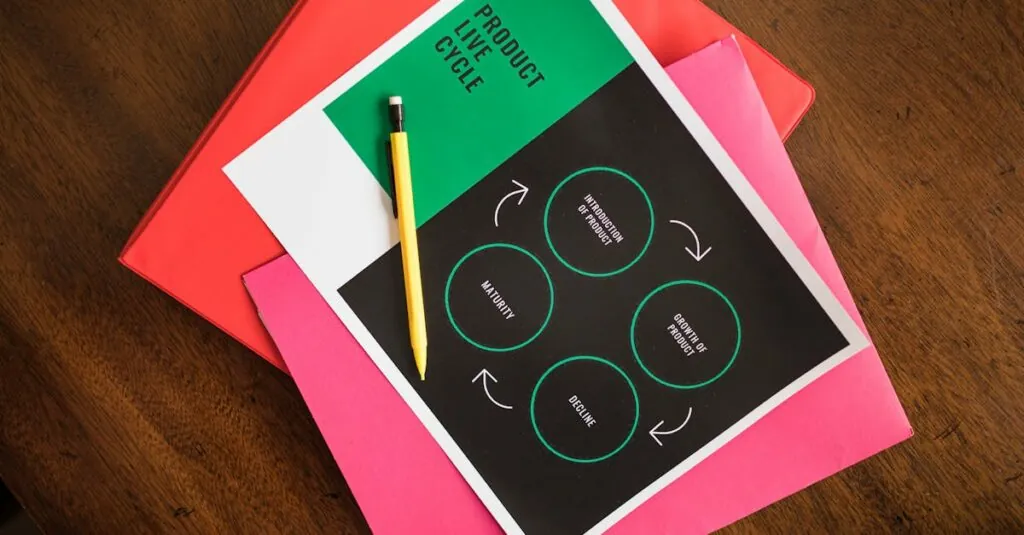Table of Contents
ToggleIn the bustling world of marketing technology, HubSpot stands out like a unicorn at a dog show. With its impressive suite of tools, it promises to transform the way businesses approach graphic design. But does it deliver, or is it just another flashy product with a pretty interface?
Overview of HubSpot and Its Marketing Tools
HubSpot offers an integrated suite of marketing tools tailored for businesses of all sizes. Its graphic design tools include features that streamline content creation and marketing efforts. Users benefit from a user-friendly interface that simplifies complex design processes.
Many organizations utilize HubSpot to create visually appealing marketing materials. The platform’s drag-and-drop editor allows for intuitive design adjustments, making it accessible for those without extensive design backgrounds. Comprehensive templates are available, catering to various marketing needs such as social media, email campaigns, and landing pages.
In terms of collaboration, HubSpot facilitates teamwork through shared assets and feedback loops. Teams can comment directly on designs, enhancing communication across departments. Additionally, HubSpot’s CMS provides seamless integration, ensuring that marketing and design efforts align effectively.
Analytics play a significant role in HubSpot’s tools. Users can track engagement metrics, allowing for informed design choices backed by real data. These insights enhance decision-making, promoting designs that resonate with target audiences.
Overall, HubSpot provides a robust environment for graphic design within its marketing toolkit. With constant updates and an evolving feature set, its capabilities cater to the growing needs of businesses that prioritize effective visual communication.
Evaluation of HubSpot’s Graphic Design Tools
HubSpot offers a diverse range of graphic design tools that cater to organizations aiming to enhance their marketing materials. These tools streamline design tasks, making it easier for users to create professional-looking content.
Features and Functionality
HubSpot provides key features that simplify graphic design processes. Users access a drag-and-drop editor, which enables quick adjustments to designs without advanced technical skills. A library of templates covers various marketing needs, including social media posts and email campaigns. Customizable elements help users maintain brand consistency while saving time. Asset sharing fosters collaboration among teams, allowing for real-time feedback and suggestions. Integration with HubSpot’s CMS amplifies marketing efforts, ensuring cohesive branding across platforms. Users can also leverage analytics tools to monitor engagement metrics, informing design decisions with actual data.
User Experience and Accessibility
User experience remains a cornerstone of HubSpot’s graphic design tools. An intuitive interface welcomes beginners while offering advanced features for experienced designers. Accessibility is enhanced through easy navigation and straightforward functionality. Resources such as tutorials and support guides assist users in maximizing the platform’s potential. Mobile optimization ensures that users can manage design tasks on the go, promoting flexibility and productivity. Continuous updates and improvements address user feedback, reflecting HubSpot’s commitment to honing its graphic design capabilities. This adaptable approach empowers businesses to utilize HubSpot effectively, regardless of their size or expertise.
Comparison with Other Martech Companies
HubSpot stands out in the marketing technology landscape, particularly regarding graphic design tools. Below are comparisons highlighting HubSpot’s strengths and limitations against other martech options.
Strengths of HubSpot
Affordable pricing models attract a wide range of businesses, from startups to established companies. A user-friendly drag-and-drop editor streamlines design processes, enhancing productivity for marketing teams. Customizable templates cater to diverse needs, allowing users to create visually appealing content quickly. Real-time collaboration features facilitate seamless teamwork, enabling colleagues to share feedback within the platform. Enhanced analytics provide actionable insights, allowing businesses to make data-driven design choices. Overall, HubSpot’s graphic design tools emphasize efficiency, accessibility, and integration with other marketing services.
Limitations of HubSpot
Limited design flexibility may restrict advanced graphic designers seeking more customization options. Some users find the learning curve steep, particularly for those new to marketing technology software. While HubSpot offers an array of templates, the design options can feel generic compared to competitors with more robust graphics capabilities. Integration with external graphic design tools may not be as seamless, posing challenges for teams accustomed to specific applications. Additional costs for premium features could deter smaller businesses from utilizing the platform to its full potential.
Case Studies and User Feedback
HubSpot has garnered various user experiences that highlight its graphic design tools’ strengths and weaknesses. Organizations have utilized the drag-and-drop editor to create marketing collateral efficiently. Several users appreciate the extensive library of customizable templates, enabling consistent branding across different campaigns.
Additionally, feedback reflects the platform’s collaborative features which allow teams to provide real-time comments directly on designs. This aspect has boosted team productivity, according to many users, as they can quickly iterate on visual assets. Users also note the ease of accessing HubSpot’s CMS, facilitating integration between design and marketing activities.
A user from a mid-sized marketing agency reported significant improvements in content creation speed after adopting HubSpot. They mentioned that the visual appeal of their outputs greatly increased due to the platform’s intuitive interface. Another user emphasized the importance of analytics, stating that the ability to track engagement metrics helped refine their design strategies effectively.
However, some feedback indicates challenges, especially for advanced users. Limitations in design flexibility have been noted, along with a feeling that templates can sometimes appear generic compared to specialized tools. Newcomers often face a steep learning curve, making initial navigation somewhat daunting. Users have also expressed concerns regarding premium features that may incur additional costs, which can deter smaller businesses from utilizing the full potential of HubSpot’s tools.
Case studies from enterprises illustrate HubSpot’s adaptability to various business sizes while highlighting its continuous updates. Users report that these updates often reflect market trends, keeping the platform relevant in the evolving landscape of graphic design for marketing. Overall, HubSpot stands out for its robust features, though potential users weigh its limitations carefully against their specific needs.
HubSpot’s graphic design tools present a compelling option for businesses seeking to enhance their marketing efforts. Its user-friendly interface and collaborative features make it accessible for teams of all sizes. The platform’s strengths lie in its extensive library of templates and real-time feedback capabilities, which foster creativity and efficiency.
Despite its advantages, potential users should consider the limitations regarding design flexibility and the learning curve for newcomers. While HubSpot continues to evolve and improve its offerings, businesses must assess whether its features align with their specific graphic design needs. Ultimately, HubSpot remains a strong contender in the martech landscape, providing valuable resources for effective visual communication.







